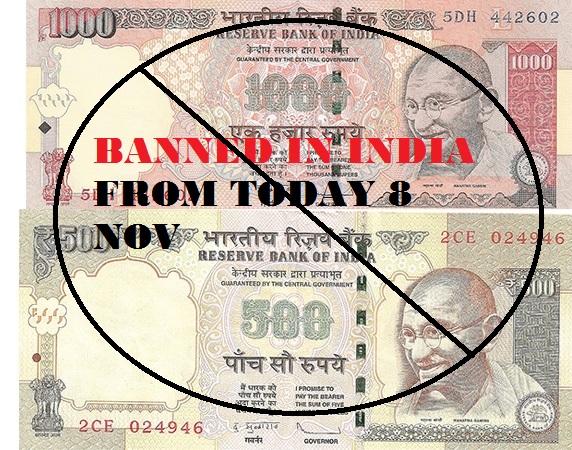Ban on Rs. 500 and Rs. 1000 Notes In India Essay, Speech, Advantages, Disadvantages, Guide to Exchange Old Notes
Why Government Banned Rs. 500 and 1000 Notes In India?
Rs 500 and Rs 1000 notes banned in India from midnight of 9th November this is the biggest headline in the country today. There is a huge panic in the general masses regarding it. The people are running to their nearest banks and post offices and other available options to exchange all these notes they have with themselves. So what lead the government to denominations of Rs 500 and Rs 1000 in India ? or Ban on Rs. 500 and 1000 INR Notes. The reason is to trace out all the unaccounted money or Black money.
Black money is one of the major hurdles in the economic growth of the country. A large amount of money is not in the circulation as it is kept hidden from the view of the Income Tax Authorities to save the tax to be paid on it. This leads to fewer amounts in the public exchequer which can be used for various developmental projects in the country.
These high value money notes are used in other public offences such as money laundering, racketeering, drugs and people trafficking. The RBI also adds another reason for this decision that there is a rise in fake money of higher denominations in India and the move will curb this problem.
So the reasons are clear. These notes of denominations of Rs 500 and Rs 1000 which are being banned in India is to the tackle the biggest problem of Black Money and fake currency in India and to tackle the problems associated with them such as trafficking which have an adverse impact on the economy.

Ban on Rs. 500 and Rs. 1000 Notes In India Essay, Speech, Advantages, Disadvantages, Guide to Exchange Old Notes
Advantages of Ban on Rs 500 and Rs. 1000 INR Notes in India
Every decision has its own impact which can be measured both on the positive and negative sides. So let us examine the positive impacts of this decision of the government
The Reduction in Black Money
The aim is to reduce black money and this can be achieved through this Ban on Rs. 500 and 1000 INR Notes. The money in circulation has been restricted in this way. The people with black money have no option but to bring out the undisclosed money with them as now this immediate decision has not given them the time to think of any alternative so soon. So they have no options but to take one of the routes provided by the government.
Tackling Counterfeit Currency
As per the data by RBI, in 2015-16 6.5 counterfeit notes were detected in the commercial banks out of which 4 lakhs were in the Rs 500 and Rs 1000 Notes category. So all those who print counterfeit notes their printing machines now are at a hault now and the fake currency can be easily dealt now.
Read Also : Jokes On Ban on 500 Rs. and 1000 Rs. Notes
Smuggling and Trafficking will get choked
These activities which are associated and grow on this black money will get chocked and they can now be easily perished due to lack of availability of funds.
The real estate sector will get more ‘white’: the real estate sector where black money is generated at an accelerating rate will get curbed efficiently. This step will give this sector more credibility and transparency.
The Benami transactions – ‘Bye Bye’: these have already received a big blow as the new legislation has a provision for seven-year imprisonment and fine, replacing the three-year jail term, or fine, or both.
Disadvantages Demonetisation of Rs. 500 and Rs. 1000 INR Notes
This all does not only has only a happy side. There are some cons associated with Ban on Rs 500 and Rs 1000 INR Notes too:
Cost of replacing these notes
There is a cost involved in the printing of these notes which varies according to the denominations of these notes for example cost of printing Rs 1000 notes is Rs 3. So a huge amount involved in printing these notes will get wasted. To put in simple words 80% of the cash in India has become worthless.
Impact on small businesses
The small businesses strive on day to day cash transactions for payments etc. They will suffer a blow in the short term till New Rs 2000 notes are in plenty supply in the economy.
Black money is still there
The major black money which is in the tax havens in the foreign banks and gold still remains unaccounted and unaffected.
The time to switch over to the new notes of Rs 500 and Rs 2000 will cause chaos and pain for a short duration of time.
How to Exchange Old Notes of Rs 500 and Rs. 1000 ?
If you too have these notes but don’t know How to Exchange Old Notes of 500 and 1000 with bank them then the following information is for you.
- The notes can be exchanged for equal amounts in the 19 offices of the RBI, any bank branch or post office.
- The electronic mean such as internet banking, IMPS and NEFT can be used to make immediate payments.
- The no frills accounts such as the Jan Dhan Yojna can be used for deposing these notes.
- A person with no personal account of her own can avail of this exchange facility via a relative/friend’s account with written permission. But while exchanging, one should provide the evidence of permission given by the account holder and own valid identity proof.
- The exchange can also be done through a third party provided one gives a written authorisation letter with the bearer, who should also prove the identity.
- On withdrawals/exchanges through ATMs, the RBI said banks will take time to re-calibrate the ATMs. Once the ATMs are functional, one can withdraw up to Rs 2,000 per card per day up to November 18. The limit will be raised to Rs 4,000 per day per card then onwards.
- Even cash withdrawal through cheque/withdrawal slips is subject to a ceiling of Rs 10,000 in a day within an overall limit of Rs 20,000 in a week (including withdrawals from ATMs) for the first fortnight-up to November 24.
- Higher value notes can be deposited/withdrawn through ATMs, cash deposit machines and cash recycles.
- Those who are outside the country can get their exchanges done by authorising in writing another person in the country to deposit the notes into your bank account with the authority letter and identity proof such as Aadhaar card, driving license, voter ID card, passport, NREGA card, PAN card etc.
- Even NRIs can also deposit the banned notes to NRO account. A visiting foreigner can purchase forex equivalent to Rs 5,000 using these illegal notes at airport exchange counters within 72 hrs after the notification, provided you present proof of purchasing these notes.
- In case of emergencies like hospitalisation, travel, lifesaving drugs, one can use the old notes to pay for hospitalisation at government hospitals, to purchase bus tickets at government bus stands for travel by state or state PSU buses, train tickets and air tickets within 72 hrs after the notification.
These were the steps for exchanging old notes of 500 Rs. and 1000 Rs with bank.
The scheme closes on 30th December until which you can exchange all your notes of these denominations of 500 and 1000 INR Notes.
The scheme has a mixed effect on the public. Some take it as a welcome step towards combating the problem of black money other regard it as a nuisance only time will tell how effective it has been. Till then exchange Rs 500 and Rs 1000 INR Notes from banks.
Highlight About New Notes of Rs. 500 and Rs. 2000
Features of the New Rs 2000 Note
1. See through register with denominational numeral 2000 can be seen when the note is held against light
2. Latent image with denominational numeral 2000 which can be seen when the banknote is held at 45 degree angle at the eye level
3. Denominational numeral 2000 in Devnagari
4. Portrait of Mahatma Gandhi in the centre
5. Micro letters ‘RBI’ and ‘2000’

Features of the New Rs 500 Note
1. See through register with denominational numeral 500 can be seen when the note is held against light
2. Latent image with denominational numeral 500 which can be seen when the banknote is held at 45 degree angle at the eye level.
3. Denominational numeral 500 in Devnagari.
4. Portrait of Mahatma Gandhi in the centre.
5. Micro letters ‘RBI’ and ‘500’
Questions Related Denominations of Rs 500 and Rs 1000
- How to Exchange 500 1000 rs notes in bank Get 2000 Rs notes Before 31st Dec 2016
- Indian New Rs 2000 and Rs 500 Currency Notes Images HD
- ATM Are Note Working People Standing In Lines Funny Images Pictures Comments Posts For FB
- Rs. 500, 1000 Notes Funny Jokes SMS Messages Memes Quotes Status For Whatsapp
- How to exchange your 500rs and 1000 rs note
- 500 Rs and 1000 Rs Notes Banned in India – How to Change 500 & 1000 Rupees Old Notes/ Currency
- How To Exchange Old Notes With Bank
- PM Modi Full Speech On 500, 1000 Rs Note Ban Details Information Video
- How to Change or exchange 500 rs Notes
- How to Change Exchange 1000 INR Notes
- 2000 Rs New Note Exchange From banks
- Jokes in Hindi on The 500 and 1000 Rupees Ban In India By Pm Narendra Modi
- Can i use 500 rs Notes in market Today
- Can i use 1000 rs Notes in market Today
- Free Download WhatsApp Funny Pics Images Photos On Black Money
- What To Do With Notes Of Rs. 500 And Rs 1000 (India banned)
- Complete details on how to exchange old Rs 500, Rs 1000 notes
- How to Exchange Old 500 Rs and 1000 Rs Notes in Different banks
- What I can do With old Rs 500 and 1000 notes ?



